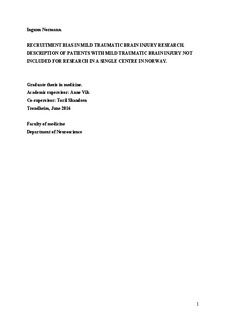| dc.description.abstract | Study aim: The aim of this study was to give a description of demographic and injury variables of the patients who were not included in the mild traumatic brain injury (TBI) study at St. Olav´s Hospital. Methods: All patients not included who; (1) had been examined with head CT because of sustained or suspected head trauma and (2) fulfilled the WHO criteria for mild TBI during the study period of the mild TBI study, were compared to the patients enrolled. Patients were referred from St. Olav’s Hospital, Trondheim municipal emergency clinic and from general practitioners in Sør-Trøndelag county and Værnesregionen emergency clinic. Results: 624 patients had a head CT and fulfilled the WHO criteria for mild TBI and 48% (n = 301) were enrolled in the mild TBI study. The remaining patients were not included, where 25% (n = 159) were missed for inclusion and 26% (n = 164) were excluded. The patients missed for inclusion tended to be younger than the patients enrolled and the injuries were more often due to violence and head CTs were more often performed during weekend nights. The patients excluded were significantly older, they were less often injured in sports accidents and if admitted, they were more often admitted to other hospital departments for treatment. Conclusion: The enrolment percentage in our study can be considered high and more representative than for previous mild TBI studies. However, this study demonstrates that there were some differences between patients enrolled and patients excluded or missed for inclusion. Hence, also this study suffers from a degree of recruitment bias with an unknown effect on study results. We experienced, that a low accuracy of mild TBI diagnosis set in outpatient clinics, combined with strict study criteria for inclusion and patients declining participation or being difficult to reach, made the inclusion of patients for our study demanding. We suspect these factors to contribute to recruitment bias in all mild TBI research. | nb_NO |
